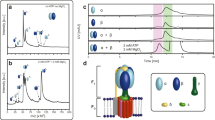Abstract
How biological systems make ATP has intrigued many scientists for well over half the 20th century, and because of the importance and complexity of the problem it seems likely to continue to be a source of fascination to both senior and younger investigators well into the 21st century. Scientific battles fought to unravel the vast secrets by which ATP synthases work have been fierce, and great victories have been short-lived, tempered with the realization that more structures are needed, additional subunits remain to be conquered, and that during ATP synthesis, not one, but several subunits may undergo either significant conformational changes, repositioning, or perhaps even physical “rotation” similar to bacterial flagella(1,2). In this introductory article, the author briefly summarizes our current knowledge about the complex substructure of ATP synthases, what we have learned from X-ray crystallography of the F1 unit, and current evidence for subunit movements.
Similar content being viewed by others
References
Berg, H. C. (1975).Nature 254, 389–392.
Macnab, R. and Aizawa, S. I. (1994).Ann. Rev. Biophys. Bioengineering 13, 51–83.
Capaldi, R. A., Aggeler, R., Turina, P., and Wilkins, S. (1994).Trends Biochem. Sci. 12, 186–189.
Boyer, P. D. (1993).Biochem. Biophys. Acta. 1140, 215–250.
Pedersen, P. L. and Amzel, L. M. (1993).J. Biol. Chem. 268, 9937–9940.
Penefsky, H. S. and Cross, R. L. (1991).Adv. Enzymol. Relat. Areas Mol. Biol. 64, 173–214.
Senior, A. E. (1990).Ann. Rev. Biophys. Biophys Chem. 19, 7–41.
Fillingame, R. H. (1990). InThe Bacteria, Academic Press, New York, pp. 345–391.
Boyer, P. D. (1989).FASEB J. 3, 2164–2178.
Soper, J. W., Decker, G. L., and Pedersen, P. L. (1979).J. Biol. Chem. 254, 11170–11176.
Gogol, E. P., Lucken, U., and Capaldi, R. A. (1987).FEBS Lett. 219, 274.
McCarty, R. E. and Hammes, G. G. (1987).Trends Biochem. Sci. 12, 234–237.
Bianchet, M., Ysern, X., Hullihen, J., Pedersen, P. L., and Amzel, L. M. (1991).J. Biol. Chem. 266, 21197–21201.
Abrahams, J. P., Leslie, A. G. W., Lutter, R., and Walker, J. E. (1994).Nature,370, 621–628.
McEnery, M. W., Hullihen, J., and Pedersen, P. L. (1989).J. Biol. Chem. 264, 12029–12036.
Walker, J. E., Gay, N. J., Powell, S. J., Kostina, M., and Dyer, M. R. (1987).Biochemistry 26, 8613–8619.
Walker, J. E., Runswick, M. J., and Poulter, L. (1987).J. Mol. Biol. 197, 89–100.
Yosihare, Y., Nagase, H., Yamani, T., Oka, H., Tani, I., and Higuti, T. (1991).Biochem. 30, 6854–6860.
Hekman, C. and Hatefi, Y. (1991).Arch. Biochem. Biophys. 284, 90–97.
Belogrudov, G., Tomich, J. M., and Hatefi, Y. (1995).J. Biol. Chem. 270, 2053–2060.
Collinson, I. R., van Raaij, M. J., Runswick, M. J., Fearnley, I. M., Skehel, J. M., Orriss, G. L., Miroux, B., and Walker, J. E. (1994).J. Mol. Biol. 242, 408–421.
BirkenhÄger, R., Hoppert, M., Deckers-Hebestreit, Mayer, F., and Altendorf, K. (1995).Eur. J. Biochem. 230, 58–67.
Pullman, M. E. and Monroy, G. C. (1963).J. Biol. Chem. 238, 3762–3769.
Amzel, L. M. and Pedersen, P. L. (1978).J. Biol. Chem. 253, 2067–2069.
Pedersen, P. L., Hullihen, J., Bianchet, M., Amzel, L. M., and Lebowitz, M. S. (1995).J. Biol. Chem. 270, 1775–1784.
Amzel, L. M., Bianchet, M., and Pedersen, P. L. (1992).J. Bioenerg. Biomemb. 24, 429–433.
Lutter, R., Abrahams, J. P., van Raaij, M. J., Todd, R. J., Lundquist, T., Buchanan, S. K., Leslie, A. G. W., and Walker, J. E. (1993).J. Mol. Biol. 229, 787–790.
Cross, R. L. (1981).Ann. Rev. Biochem. 50, 681–714.
Daggett, S. G., Tomaszek, T. A., Jr., and Shuster, S. M. (1985).Arch. Biochem. Biophys. 236, 815–824.
Vasilyeva, E. A., Minkov, I. A., Fitin, A. F., and Vinogradov, A. D. (1982).Biochem. J. 202, 15–23.
Ebel, R. E., and Lardy, H. A. (1975).J. Biol Chem. 250, 191–196.
Pedersen, P. L. (1976).J. Biol. Chem. 254, 934–940.
Catterall, W. A. and Pedersen, P. L. (1974).Biochem. Soc. Spec. Publ. 4, 63–88.
Cross, R. L., Grubmeyer, C., and Penefsky, H. S. (1982).J. Biol. Chem., 12101–12105.
Reynafarje, B. D. and Pedersen, P. L. (1996).J. Biol. Chem., in press.
Watts, S. D., Zhang, Y., Fillingame, R. H., and Capaldi, R. A. (1995)FEBS Lett. 368, 235–238.
Duncan, T. M., Bulygin, V., Zhou, Y., Hutcheon, M. L., and Cross, R. L. (1995).Proc. Natl. Acad. Sci. (USA) 92, 10964–10968.
Turina, P. and Capaldi, R. A. (1994).Biochem. 33, 14275–14280.
Turina, P. and Capaldi, R. A. (1994)J. Biol. Chem. 269, 13465–13471.
Sabbert, D., Engelbrecht, S., and Junge, W. (1996).Nature, 623–625.
Gogol, E. P., Johnston, E., Aggeler, R., and Capaldi, R. A. (1990).Proc. Natl. Acad. Sci. (USA) 87, 9585–9589.
Capaldi, R. A., Aggeler, R., Wilkens, S., and Grüber, G. (1996).J. Bioenerg. Biomembr. 28, 397–401.
Vik, S. B. and Antonio, B. J. (1994).J. Biol. Chem. 269, 30364–30369.
Zhang, F. X., Pan, W., and Hutchins, J. B. (1995).J. Neurochem. 65, 2812–2815.
Howitt, S. M., Rodgers, A. J. W., Hatch, L. P., Gibson, F., and Cox, G. B. (1996).J. Bioenerg. Biomemb. 28, 415–420.
Webster's New Collegiate Dictionary (1974). G. & C. Merriam Co., Springfield, Ma, p. 1137.
Author information
Authors and Affiliations
Rights and permissions
About this article
Cite this article
Pedersen, P.L. Frontiers in ATP synthase research: Understanding the relationship between subunit movements and ATP Synthesis. J Bioenerg Biomembr 28, 389–395 (1996). https://doi.org/10.1007/BF02113979
Received:
Accepted:
Issue Date:
DOI: https://doi.org/10.1007/BF02113979




